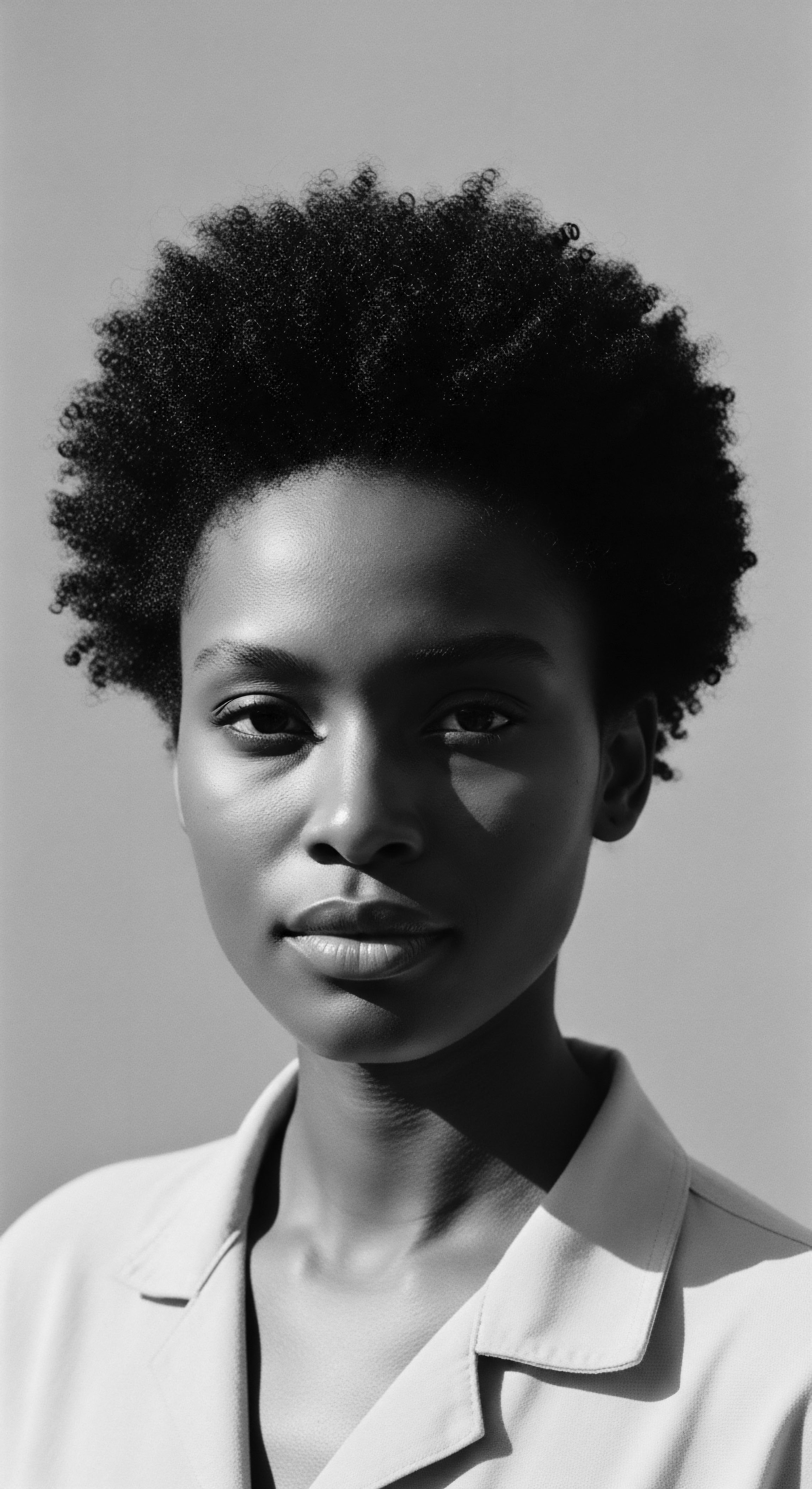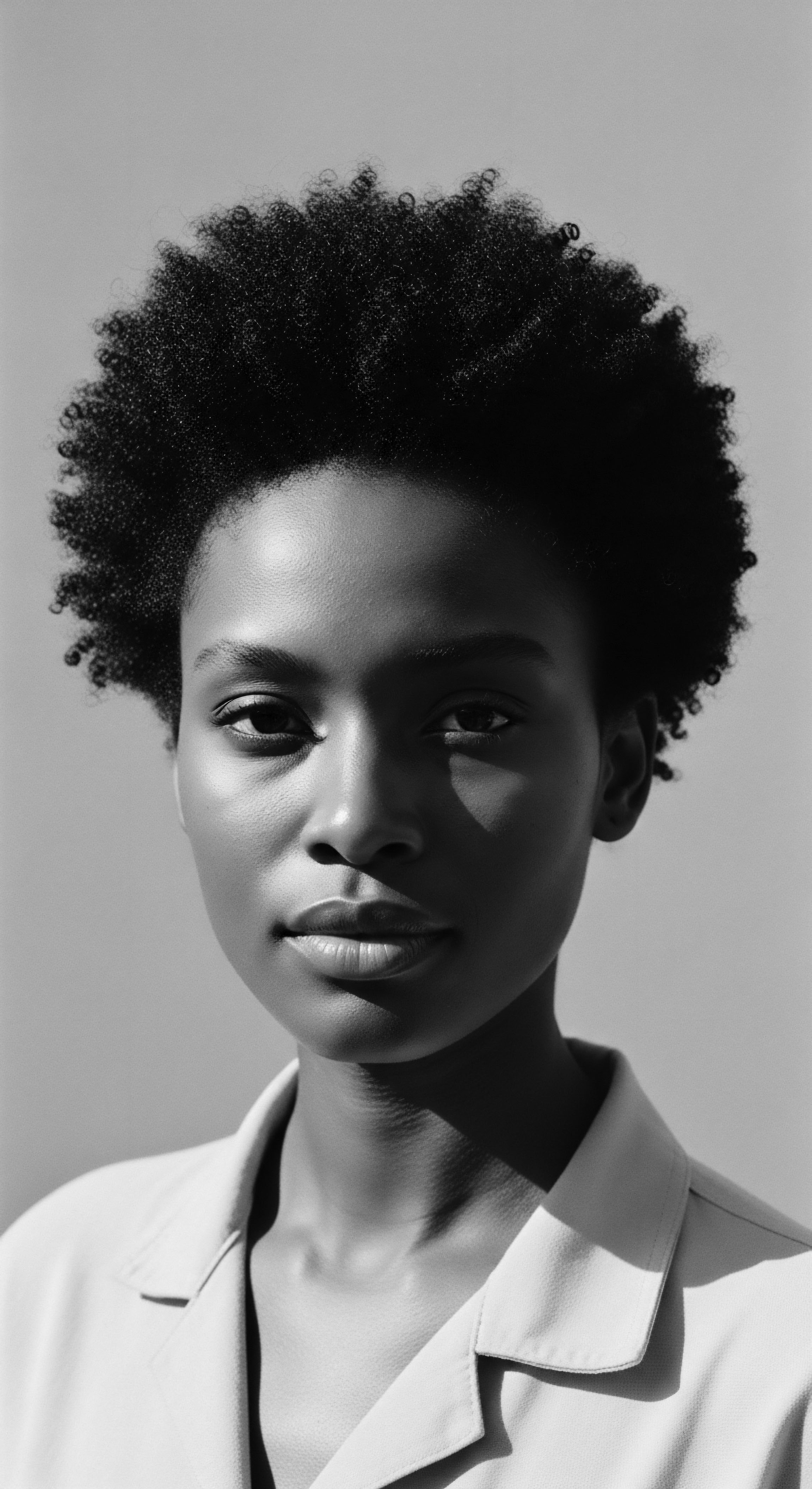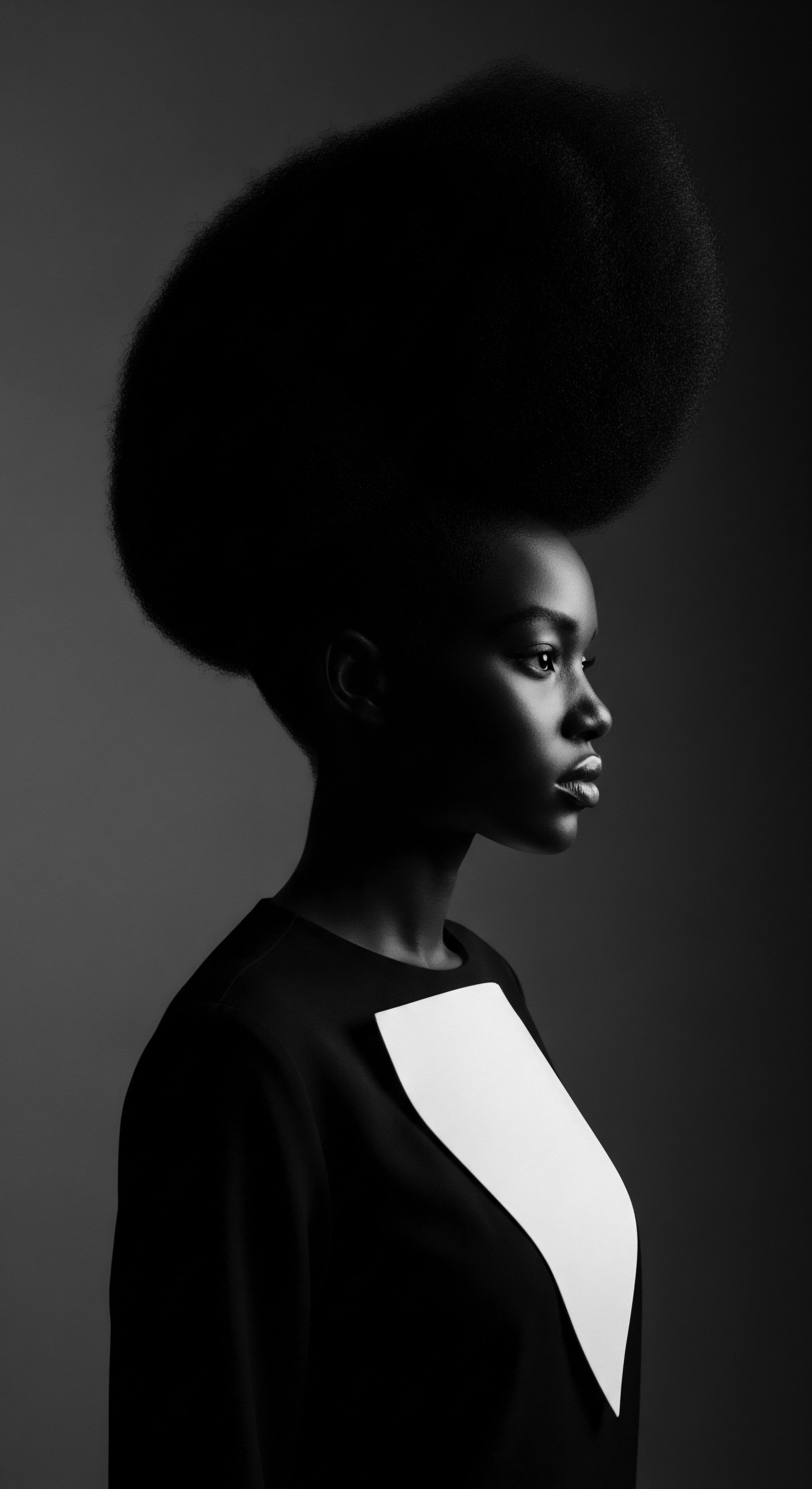
Roots
To truly understand the global perception of textured hair, one must journey back through the winding paths of history, beyond the immediate horizon of what is seen today, to the ancestral wellsprings where reverence for hair pulsed as a living truth. For those whose ancestry traces through the African continent and across the diaspora, hair is never merely a collection of strands. It is a profound script written upon the body, speaking volumes about lineage, social standing, and spiritual connection.
Before the brutal ruptures of transatlantic enslavement, African societies held hair in the highest esteem. Hairstyles were intricate declarations, a visual language conveying an individual’s ethnic group, age, marital status, wealth, and role within the community.
The meticulous creation of these styles often required hours, even days, serving not solely as aesthetic endeavors but as cherished social rituals. These communal sessions built bonds, shared stories, and transmitted ancestral knowledge across generations. In some traditions, particularly among the Yoruba, hair was considered the most elevated part of the body, a conduit to the divine.
Braided patterns could even carry messages to the gods. This deep, inherent value stands in stark contrast to the narratives that would later be imposed, narratives that sought to strip textured hair of its dignity.
The story of textured hair is an unfolding scroll of cultural identity, resilience, and profound historical shifts.

Hair as a Cultural Map and Spiritual Anchor
Before the forced displacements, hair on the African continent served as a living archive, a dynamic atlas of identity. The specific braids, twists, and locs were not arbitrary choices. They encoded information, allowing members of a community to discern a stranger’s origins, their spiritual beliefs, or their place within the social hierarchy.
One might observe the precise parting of a cornrow, the placement of cowrie shells, or the length of a twisted section to grasp layers of meaning. These were expressions of power, spirituality, and social cohesion, often adorned with precious materials like gold and beads, signifying wealth and a direct connection to the divine.
Consider the practices of various communities:
- Himba People of Namibia ❉ Their distinctive ochre-coated dreadlocks, known as ‘otjize’, tell tales of age, marital status, and ritual significance, intertwined with their nomadic existence and connection to the land.
- Ancient Egyptians ❉ Elaborate wigs and intricate braiding, often symbolic of hierarchy and divinity, marked the elite classes, using human hair, wool, and plant fibers.
- West African Cultures ❉ Braids served as a sophisticated communication medium, with patterns carrying coded messages about tribal affiliation or even mapping escape routes during later periods of subjugation.
The meticulous care and adornment reflected a fundamental understanding of hair as an extension of the self, deeply tied to the spiritual and communal fabric of life. This reverence was deeply ingrained, so much so that in some Nigerian traditions, an “undone” appearance of hair could signal distress or even a state of mental un-wellness. This pre-colonial context is essential, for it highlights the profound loss and deliberate erasure that followed, setting the stage for centuries of shifting perception.

The Anatomy of Textured Hair ❉ An Ancestral Understanding
From a scientific lens, textured hair possesses unique characteristics that render it distinct from straight hair. Its elliptical follicle shape, combined with the way keratin proteins coil upon themselves, gives rise to its signature curves and spirals. This inherent curl, whether a gentle wave or a tight coil, affects how natural oils travel down the strand, influencing moisture retention.
While modern trichology dissects these aspects with microscopes and molecular diagrams, ancestral wisdom intuitively grasped the specific needs of textured hair. They understood that these coils required nurturing, protection, and specific methods of care.
This traditional understanding was not about deficiency or “difficulty,” but about intrinsic difference and the specific rituals that honored this unique biology. Pre-colonial African communities certainly understood the science of their hair, not in a laboratory sense, but through generations of careful observation and practice. They developed sophisticated methods and rich repertoires of plant-based oils, butters, and cleansing agents, all designed to maintain the vitality of these distinct strands. The collective wisdom passed through generations was, in itself, an empirical science, refined over millennia.

Ritual
The catastrophic arrival of the transatlantic slave trade violently severed millions from their homelands, their families, and their deeply rooted hair traditions. This seismic historical event inflicted immediate, profound damage on the global perception of natural textured hair. Slave traders frequently shaved the heads of captured Africans, an act deliberately intended to strip individuals of their identity, humiliate them, and sever their ties to their ancestral heritage. This initial act of dehumanization laid a harrowing groundwork for centuries of denigration.
Transported to new, unfamiliar landscapes with limited or no access to their traditional tools, oils, or the communal time once dedicated to hair care, enslaved Africans faced immense challenges. Their hair, once a symbol of pride and spiritual connection, often became matted and tangled. The prevailing European beauty standards of the time, characterized by straight hair and lighter skin, were forcibly imposed.
African textured hair was pathologized, labeled as “wool-like,” “unkempt,” or “animalistic” by slaveholders and the wider colonial society. This racist rhetoric fueled an internalized belief among some enslaved people that their hair was inherently “bad” or “inferior.”
The forced alteration of beauty ideals during slavery carved a painful chasm between textured hair’s ancestral reverence and its subjugated reality.

How Did Coercion Reshape Hair Practices?
In the brutal hierarchy of the slave plantation, the texture of an enslaved person’s hair could dictate their living conditions and perceived worth. Individuals with lighter skin and looser curl patterns, often the result of non-consensual relations with enslavers, were sometimes granted preferential treatment, such as work inside the “big house.” This created a perverse system where proximity to European features, including hair texture, could determine access to slightly less arduous labor and even limited opportunities. This oppressive environment spurred the creation and adoption of methods to straighten textured hair, not primarily for aesthetic preference, but as a desperate means of survival and an attempt to mitigate harsh discrimination.
Early methods of hair alteration were rudimentary and often damaging. Accounts tell of enslaved people using hot butter knives, lye, and potatoes to achieve a straightened appearance. These practices highlight the immense pressure to conform to Eurocentric beauty norms, driven by the desire to avoid mistreatment and access opportunities in a society that increasingly equated straight hair with “good hair” and respectability.
The enduring legacy of this era manifests in the concept of “good hair” versus “bad hair,” a harmful construct that still affects perceptions within the Black and mixed-race communities.

The Genesis of Chemical Alteration and Its Societal Roots
The late 19th and early 20th centuries witnessed the advent of commercial hair straightening products, fundamentally altering the landscape of Black hair care. The invention of the chemical hair relaxer by Garrett Augustus Morgan in 1909 marked a turning point. Initially a solution to ease friction on sewing machine needles, Morgan adapted his discovery, and his G.A. Morgan Hair Refining Company began selling products to Black and mixed-race communities.
Later, George E. Johnson developed a permanent hair straightener for men in 1954, which also saw a female version emerge.
| Historical Implement Hot Combs (Pressing Combs) |
| Traditional Use and Evolution Originating around 1845 in France, these metal combs heated on stoves became household staples in Black communities by the 1880s, providing a temporary straightening effect. |
| Societal Context of Adoption Offered a means to temporarily conform to dominant beauty standards, particularly for those seeking social or economic advancement. |
| Historical Implement Chemical Relaxers (Early Lye Formulas) |
| Traditional Use and Evolution Developed in the early 20th century, these strong alkaline creams chemically broke down hair bonds for a more lasting straightness. |
| Societal Context of Adoption Marketed for "manageability" and assimilation, these products became synonymous with achieving a "respectable" appearance in a discriminatory society. |
| Historical Implement Headwraps |
| Traditional Use and Evolution In pre-colonial Africa, a functional and stylistic garment. During slavery, a practical covering for hygiene and a subtle act of defiance, later enforced by laws like the Tignon Law in Louisiana. |
| Societal Context of Adoption Initially a forced concealment, Black women transformed headwraps into elaborate, artful expressions, subverting oppressive intentions. |
| Historical Implement These tools and practices illustrate the complex interplay between oppressive external pressures and the resilient human spirit's adaptations and subversions. |
These products, while offering a means to achieve desired straightened styles, were simultaneously marketed in ways that perpetuated negative perceptions of natural textured hair. Advertisements often paired images of straight, “silky” hair with terms implying desirability, subtly reinforcing the notion that naturally curly hair was less acceptable. This era saw the rise of Black-owned beauty empires, such as Madam C.J. Walker’s, which, while creating economic opportunities for Black women, also contributed to the widespread adoption of straightening as a norm.
The Great Migration, a significant demographic shift where millions of African Americans moved from the rural South to Northern and Midwestern cities, further influenced hair practices. As people sought new lives and opportunities, there was a desire among some to shed associations with rural poverty and conform to urban, often Eurocentric, beauty standards. This desire, whether interpreted as a bid for acceptance or a personal fashion choice, solidified the prominence of straightened hair in Black communities for decades.

Relay
The mid-20th century ignited a powerful resurgence of self-acceptance and cultural affirmation within Black communities, profoundly altering the global perception of natural textured hair. The burgeoning Civil Rights Movement and its subsequent evolution into the Black Power Movement served as an undeniable catalyst. This was a period when African Americans, frustrated by persistent racism and the futility of striving for assimilation, began to declare that “Black is beautiful” with an unapologetic conviction. Hair, in its most authentic, coily, and kinky form, became a potent symbol of this resistance.
The Afro, a voluminous, often spherical shape of natural textured hair, emerged as an iconic statement of Black pride, unity, and defiance against Eurocentric beauty norms. Figures like Angela Davis and members of the Black Panther Party popularized the Afro, transforming a hairstyle into a political declaration. Wearing an Afro was not simply a style choice; it was a protest, a rejection of decades of imposed standards, and an affirmation of African heritage.

How Did Societal Shifts Reimagine Hair as a Statement?
The shift from straightened hair to the unapologetic embrace of natural textures was a deeply personal and collective act of liberation. It represented a conscious decision to reclaim a physical attribute that had been demonized and to redefine beauty on one’s own terms. This period saw a powerful critique of hair straightening, with some activists viewing it as an act of internalized oppression, a means of “simulating Whiteness.” Marcus Garvey’s earlier call to “Don’t remove the kinks from your hair! Remove them from your brain!” found renewed resonance, becoming a rallying cry for self-acceptance.
A telling statistic from this era illuminates the shift ❉ a 1972 study of Black teenagers in St. Louis revealed that 90 percent of young men and 40 percent of young women wore their natural kinks, a marked increase from previous decades. While small in scope, this data points to a broader national trend of re-embracing natural hair. This was a period when hair, unequivocally, became a site of political struggle and self-expression.
Beyond the Afro, other traditional styles like cornrows, braids, and Bantu knots gained prominence, their historical roots acknowledged and celebrated. These styles were increasingly seen as authentic expressions of African heritage, no longer hidden or scorned, but worn with pride.

The Unbound Helix ❉ From Movement to Mainstream, and the Ongoing Journey
The energy of the 1960s and 70s, while transformative, eventually waned, giving way in the 1980s and 90s to a renewed prevalence of chemically straightened or permed styles, such as the Jheri curl. This shift was influenced by media portrayal and advertising campaigns that continued to push altered hair textures. Yet, beneath the surface, the seeds of natural hair acceptance had been sown.
The 2000s marked the “second wave” of the natural hair movement, spurred significantly by the rise of the internet and social media. Online communities formed, offering platforms for sharing tips, celebrating diverse curl patterns, and providing education that was previously inaccessible. This digital connection allowed millions of Black and mixed-race individuals to collectively embark on or rediscover their natural hair journeys, leading to a cultural shift away from relaxers and pressing combs. The phrase “nappy,” once a derogatory term tied to slavery, was actively reclaimed as a term of affirmation.
This modern movement has had tangible legal and social repercussions. Hair discrimination, rooted in the centuries-old bias against textured hair, continues to be a lived reality for many. Studies have shown that Black women with natural hairstyles are perceived as less professional and face employment barriers compared to those with straightened hair.
In response, legislation like the CROWN Act (Creating a Respectful and Open World for Natural Hair) has emerged in the United States, aiming to prohibit discrimination based on hair texture and protective styles. These legislative efforts underscore the ongoing societal struggle for complete acceptance of natural Black hair, making it clear that its journey is far from over.
- Civil Rights Act of 1964 ❉ While not initially addressing hair discrimination directly, its principles laid the groundwork for future legal challenges, with some courts later upholding rights to wear Afros.
- Black Power Movement’s Afro ❉ A visible statement of political commitment, self-love, and rejection of assimilation, transforming a hairstyle into a symbol of resistance.
- The CROWN Act ❉ Modern legislation addressing systemic hair discrimination, reflecting a continued legal and social battle for the freedom to wear natural hair without prejudice.

Reflection
The lineage of textured hair is a testament to unwavering human spirit, a living archive inscribed with both profound sorrow and glorious triumph. From the ancestral villages where hair communicated identity and divinity, through the brutal passages of enslavement where its beauty was denied, to the vibrant affirmations of contemporary movements, each strand holds a story. It is a story not of simple evolution, but of a purposeful return, a remembering of what was lost, and a passionate declaration of inherent worth. The perception of natural Black hair heritage has flowed through eras of denigration and attempted erasure, yet it consistently resurfaces, bolder and more resilient.
The shifts in global perception mirror the broader struggles for human dignity and self-determination. In this journey, hair emerges as a sacred canvas, continually painted with the brushstrokes of history, culture, and personal expression. As we witness more individuals embracing their true textures, we observe more than a style choice; we see a deep connection to lineage, a conscious honoring of ancestral wisdom, and a powerful vision for a future where every helix, unbound and celebrated, contributes to the luminous spectrum of human beauty.

References
- Byrd, Ayana, and Lori L. Tharps. Hair Story ❉ Untangling the Roots of Black Hair in America. St. Martin’s Press, 2001.
- Patton, Tracey Owens. “Hey Girl, Am I More Than My Hair?” Journal of Pan African Studies, vol. 3, no. 1, 2009.
- Sherrow, Victoria. Encyclopedia of Hair ❉ A Cultural History. Greenwood Press, 2006.
- Okoro, Nkiru. Black Hair ❉ A Cultural History. Bloomsbury Publishing, 2021.
- Mercer, Kobena. Hair Story ❉ Untangling the Roots of Black Hair in America. St. Martin’s Press, 2001.
- Banks, Ingrid. Hair Matters ❉ Beauty, Power, and Black Women’s Consciousness. New York University Press, 2000.
- Rooks, Noliwe M. Hair Raising ❉ Beauty, Culture, and African American Women. Rutgers University Press, 1996.
- Hunter, Tera W. To ‘Joy My Freedom ❉ Southern Black Women’s Lives and Labors After the Civil War. Harvard University Press, 1997.
- Walker, A’Lelia Bundles. On Her Own Ground ❉ The Life and Times of Madam C. J. Walker. Scribner, 2001.
- Coleman, L. “Black Women’s Hair and the Politics of Race ❉ A Critical Analysis of the Black Is Beautiful Movement.” Journal of Black Studies, vol. 37, no. 1, 2006, pp. 31-43.
